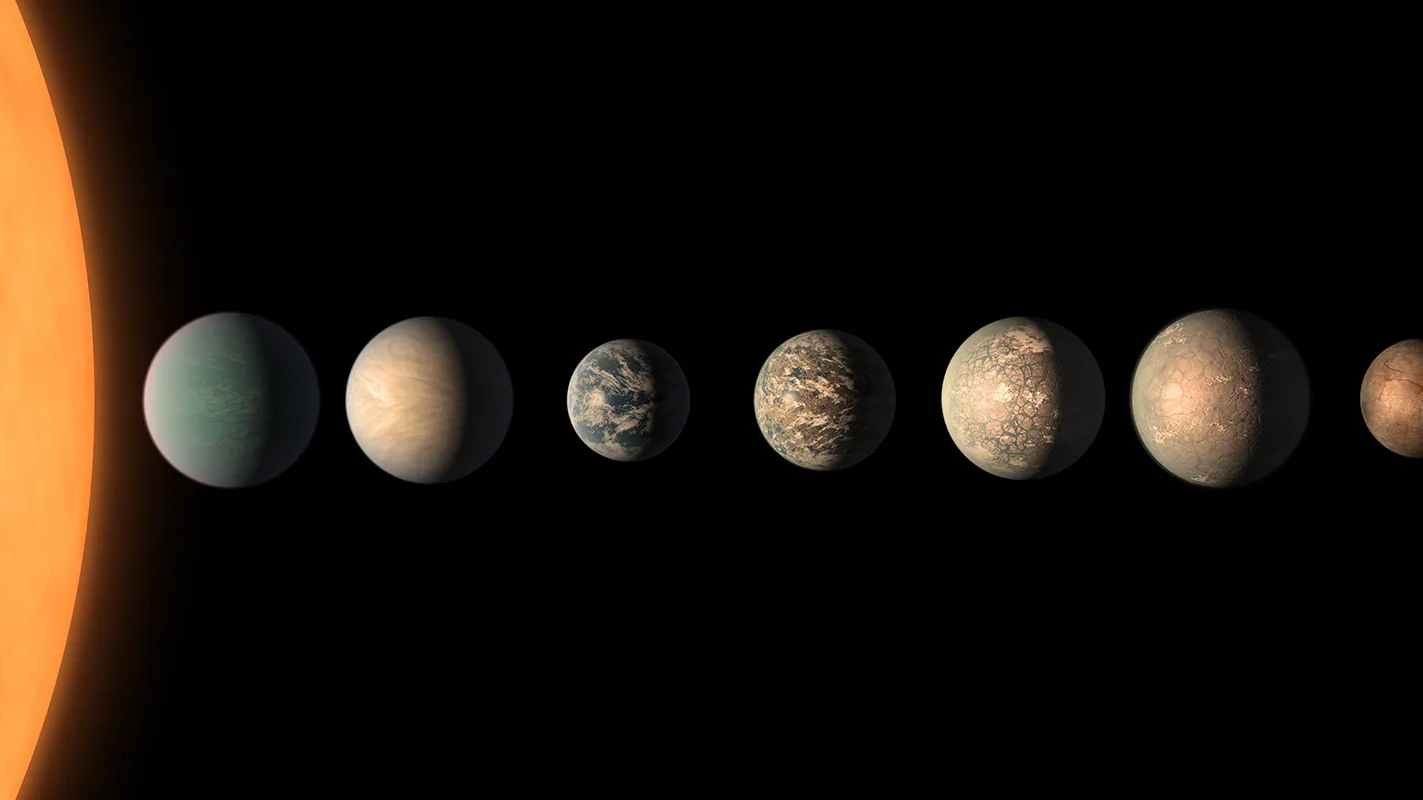Why the 7 worlds of TRAPPIST-1 waltz in peculiar patterns
The stability of the TRAPPIST-1 system is the result of a more unstable past.

Scientists may have finally revealed the history of the tantalizing TRAPPIST-1 system, an intricate collection of seven worlds that sit about 40 light-years away from us. These worlds, many astronomers and astrobiologists say, may offer us a promising chance of finding life outside the solar system — but they also exhibit peculiar orbital patterns.
The newly outlined history of TRAPPIST-1 may, at last, explain how those patterns came to be.
When planets form around a young star, their orbital periods often enter "resonances" with each other. An everyday example of a resonance has to do with pushing someone on a playground swing — if you time the push to coincide with the natural frequency of the swing, such as when the swing is just about to go back down, your push would amplify the size of the swing's arc.
Similarly, planets often find themselves in resonances with each other. For example, an inner planet can orbit exactly twice for every one orbit of an outer planet. This is a 2:1 resonance, and like pushing a child on a swing amplifies how fast they swing, the exchange of gravitational energy between resonant planets usually makes their orbits unstable, amplifying orbital periods until the planets eventually move out of resonance with one another. Another common planetary resonance is 3:2.
Related: TRAPPIST-1: A guide to the system with 7 Earth-size exoplanets
For the above reason, planetary resonances often become unstable over time, such as in our solar system — but not always. Some planetary systems manage to keep their resonance patterns, and TRAPPIST-1 is one of those systems.
Systems with stable resonances are no doubt aided by how compact the system is; TRAPPIST-1's seven worlds are spread across less than 8 million kilometers, and they would all easily fit inside the orbit of Mercury multiple times over.
Get the Space.com Newsletter
Breaking space news, the latest updates on rocket launches, skywatching events and more!
TRAPPIST-1's outer three planets — designated f, g and h — are in a chain of 3:2 resonances.
"The outer planets behave properly, so to speak, with the simpler expected resonances," said Gabriele Pichierri, who is a planetary scientist at Caltech, in a statement. "But the inner ones have resonances that are a bit spicier."
For example, the orbital periods of the two innermost planets, b and c, are in an 8:5 resonance, meaning planet b orbits eight times for every five orbits of planet c. Meanwhile, planets c and d are in a 5:3 resonance.
So, how did these complex arrangements arise?
Pichierri is the lead author of a new research paper that delves into the early history of TRAPPIST-1 to discover how its planets wound up in this delicate configuration. The crew found a story of a shifting protoplanetary disk of gas and dust combined with powerful torques that pushed the planets around.
The innermost planets would have formed first, so Pichierri and his team divided the TRAPPIST-1 system into two sub-groups — the inner planets b, c, d and e, and the outer planets f, g and h. (Unlike our solar system, in which the outer planets are gas giants, the outer planets of TRAPPIST-1 are rocky worlds.) Their modeling identified three phases in the evolution of the system.
Here's what the team found.
In the first phase, the four innermost planets all start life in 3:2 resonances with each other, so b and c are in a 3:2 orbital resonance, as are c and d, and d and e. As the inner planets formed out of material from the protoplanetary disk, and their burgeoning red dwarf star ignited nuclear fusion in its core and produced radiation that began to dissipate the disk, the inner edge of the disk would have receded outwards.
In the second phase, planet e, anchored in the receding inner edge of the disk, would have found itself being dragged outwards, away from planets b, c and d and towards the worlds forming in the outer part of the system. This had the effect of causing the orbits of planets b, c and d to waver, and they crossed through the 8:5 and 5:3 resonances as their orbital periods widened, but were then pushed back via a gravitational torque (a twisting, rotational force) from the outer system, until they settled into the 8:5 and 5:3 resonances that they have today.
What of planet e, though? By the final phase, the three outer worlds had formed. Often, when planets form in a protoplanetary disk, they shed orbital angular momentum, exchanging this angular momentum with the disk that they are accreting material from in order to grow. This results in them migrating towards the inner edge of the disk. In the TRAPPIST-1 system, this likely had the effect of pushing planet e back, until the inner and outer parts of the planetary system settled into the configuration that they are in today.
"By looking at TRAPPIST-1, we have been able to test exciting new hypotheses for the evolution of planetary systems," said Pichierri. "TRAPPIST-1 is very interesting because it is so intricate: it’s a long planetary chain, and it’s a great exemplar for testing alternative theories about planetary system formation."
The research was published on Aug. 20 in the journal Nature Astronomy.
Join our Space Forums to keep talking space on the latest missions, night sky and more! And if you have a news tip, correction or comment, let us know at: community@space.com.

Keith Cooper is a freelance science journalist and editor in the United Kingdom, and has a degree in physics and astrophysics from the University of Manchester. He's the author of "The Contact Paradox: Challenging Our Assumptions in the Search for Extraterrestrial Intelligence" (Bloomsbury Sigma, 2020) and has written articles on astronomy, space, physics and astrobiology for a multitude of magazines and websites.









